
This blog post builds on my recent Leadership Meets Life Podcast Episode 02: Polarities & Conflict: Using Both-And Thinking to Lead.
In the second half of that podcast, I introduced the work of authors Kelly Lewis and Brian Emerson, who developed an elegant model developed in their book Navigating Polarities: Using Both/And Thinking to Lead Transformation.
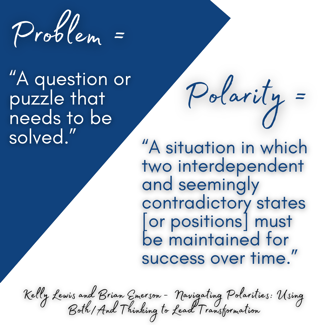
The authors differentiate between a problem and a polarity.
A problem, they note, is: “A question or puzzle that needs to be solved.”
In contrast to a problem, a polarity is: “A situation in which two interdependent and seemingly contradictory states [or positions] must be maintained for success over time.”
A fundamental polarity is breathing. We inhale, and we exhale. Both poles need each other for the good of the whole body. And too much of either pole is not good, with either not enough oxygen or too much carbon dioxide building up. The benefits of both poles are needed even though, paradoxically, they are opposites.
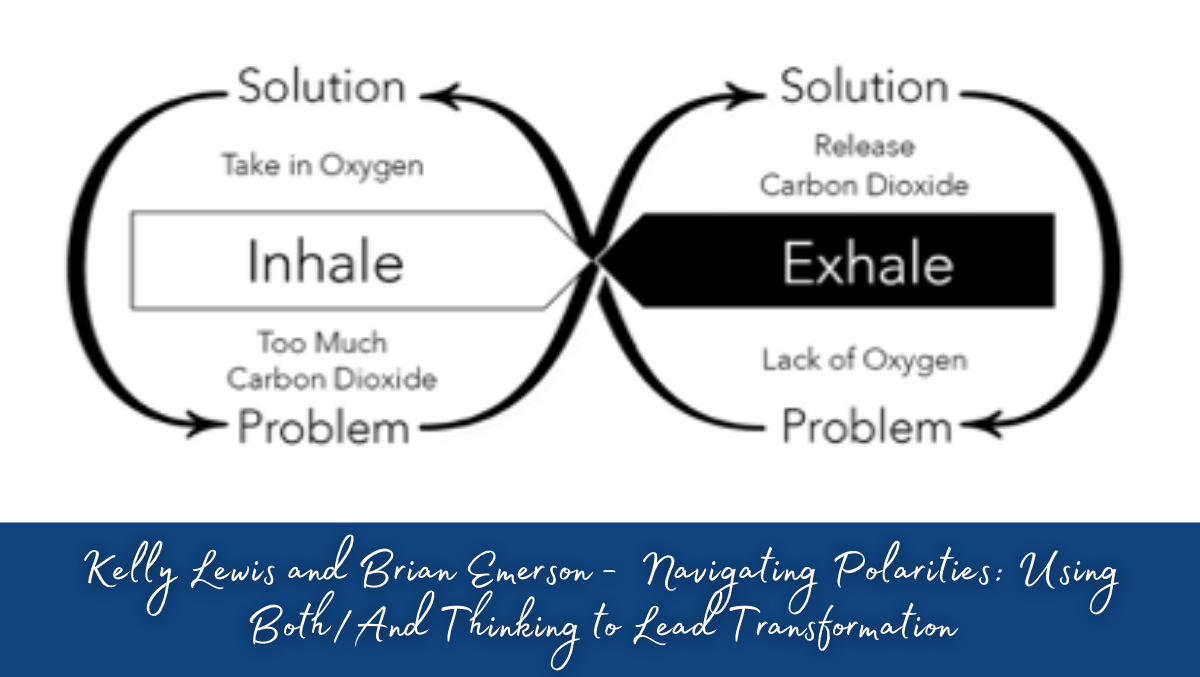
Another polarity Emerson and Lewis offer that is typical in both leadership and life are the two poles, Compete and Collaborate. When both are held in dynamic tension, the results are much better than focusing too much on one at the expense of the other, which Emerson and Lewis call overuse.
To illustrate, the benefits of Compete include the ability to drive excellence, to do so quickly, with the advantage of personal gain. Collaborate benefits include connected relationships, more likelihood of generative ideas, and greater buy-in by others.
But look what happens when we take either pole into excess, resulting in overuse.
Overuse the Compete pole, and you can get backstabbing, little to no idea sharing, and the absence of shared successes. The overuse of the Collaborate pole and you end up with sluggish processes primarily due to having to please everyone and solutions that are too easily watered-down. [If you’re familiar with the work of Patrick Lencioni, he would argue that the inability to engage ideas to improve them to the point of excellence is due to insufficient trust levels to sufficiently engage to the point of constructive conflict for the good of our shared work.]
You might find the overuses noted above as obvious or even exaggerated, except that we all tend toward one pole over the other. Be honest! There are likely few polarities in which you don’t have a leaning or preference. And guess what happens when you have a preference?
The authors refer to a tendency to spiral either down or up as we identify with a particular pole.
Stepping downward leads to what Emerson and Lewis call Suffering Paradox. Take a look at the figure below that moves downward from simply having a preference; to getting attached to the preference; to what they call othering, and then all the way to either/or-ing.
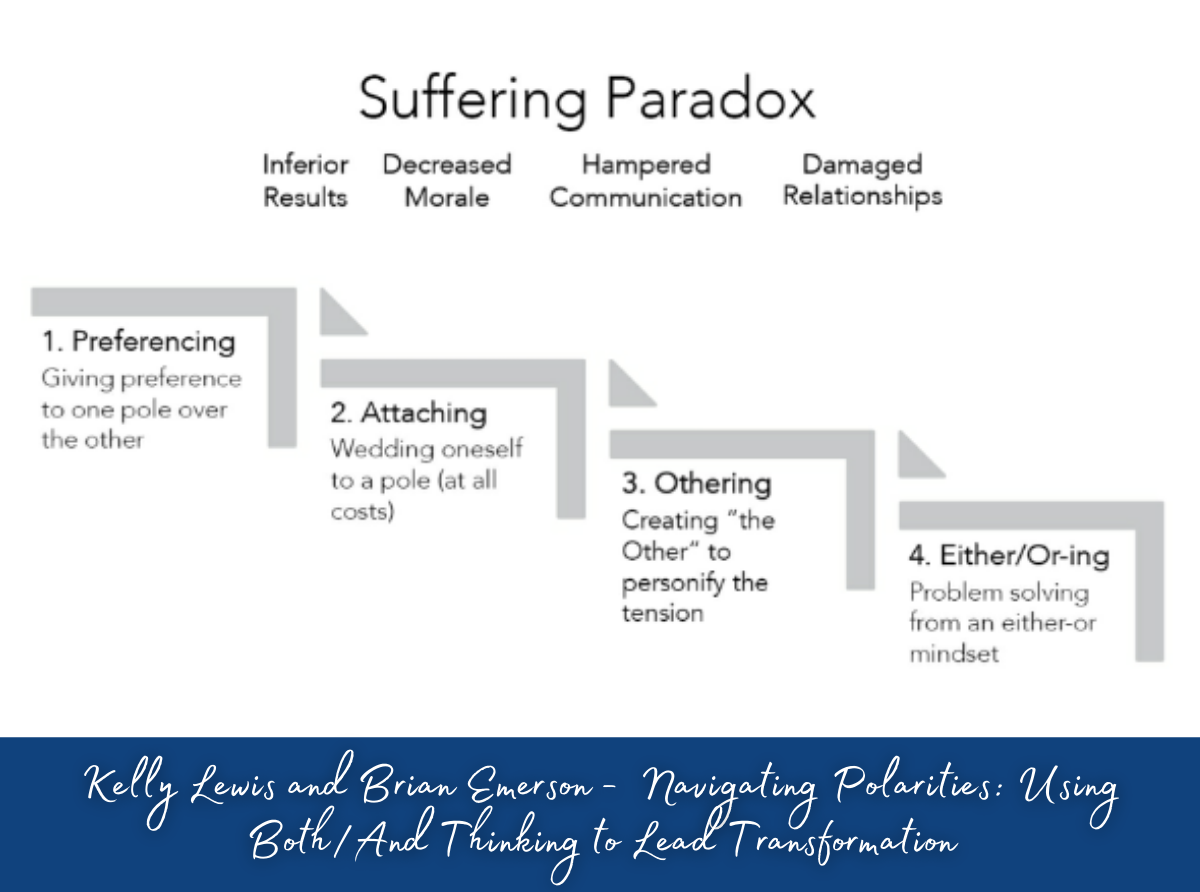
Think about the most recent political cycle. Chances are pretty good that you had, let’s call it, a preference! And if you had a political preference, you likely viewed the benefits of your “pole” while “othering” the overuses of the other pole.
Comparing my benefits to (my perception of) your overuses is hardly a fair—or helpful— comparison! And so, the Suffering Paradox approach steps downward with inferior results, decreased morale, hampered communication, and damaged relationships.
"When viewed through its overuse, any pole looks wrong."
- Kelly Lewis & Brian Emerson
Why does this happen?
Psychiatrist Carl Jung once said:
“We all feel that the opposite of our own highest principle must be purely destructive, deadly, and evil. We refuse to endow it with any positive life-force; hence we avoid and fear it.”
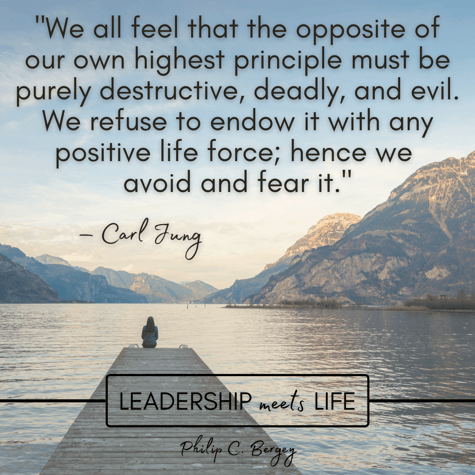
Whether or not you are Jungian in your outlook, there does seem to be a human tribe tendency toward favoring one thing over the other and quickly seeing the benefits of “my view” and the disadvantages, overuses, or abuses of “the other.” The Democrat versus Republican bruhaha in the US is—sadly, in my mind—a perfect example. Or think about catch-and-release flyfishing for trout versus dunking worms for catfish. Or sports teams: Seahawks versus the Eagles or Bears versus the Broncos (I realize there are more intense rivalries in sports like Packers-Vikings or Yankees-Red Sox, but I was looking for animals to make a case for what sociologist Emile Durkheim called totems).
Emerson and Lewis put it this way:
“When we prefer a pole, we value the benefits of that pole—they are the things that excite us, shape what we think is important in the world, motivate and drive our actions and decisions, and possibly define who we are. Conversely, we typically fear, or don’t like, the overuses of the opposite pole. These things threaten the things we value, so therefore we will do whatever we can to move away from them or to make sure they don’t happen. This sets up what we call a diagonal perspective.”
But there is another way!
Instead of stepping downward, we can choose to step upward. In comparison to Suffering Paradox—as if something is happening to us, stepping up is called Navigating Paradox. It is a posture we can actively and constructively choose, and it looks like this:
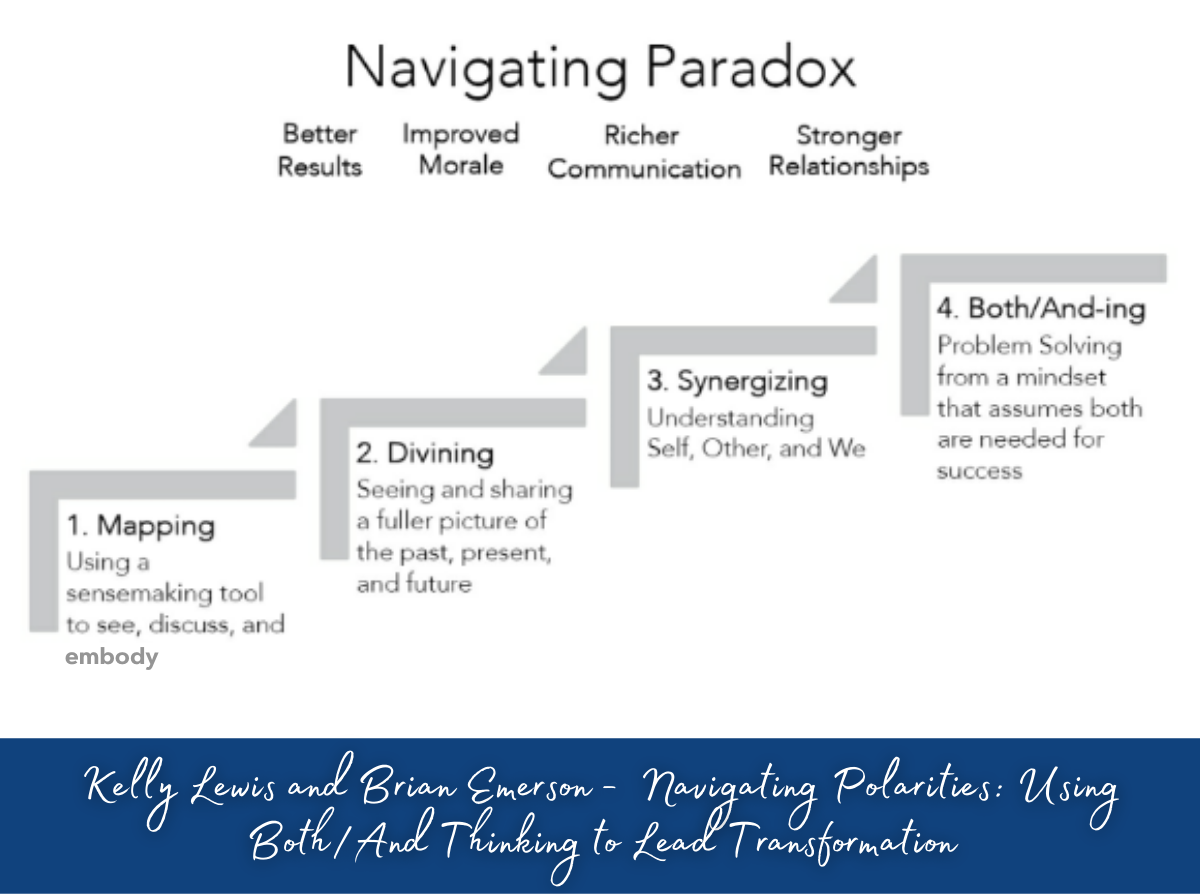
Stepping upwards leads to actively Navigating Paradox. The figure above moves from:
Mapping: using a tool/approach to make sense in order to see, discuss and embody; to
Diving: discerning the bigger picture (what MIT economist Otto Scharmer calls being present to all that we are sensing); to
Synergizing: where we can understand not only self but also others; and then to
Both/and-ing: a problem-solving posture with a mindset that understands that both poles are needed for success.
Another way to think about this is using the terminology of Harvard psychologists Lisa Lahey and Robert Kegan. They have developed an elegant model that allows a person or group to move from something having us (subject) to us having it (object). By exercising our conscious choice of having it—that is, naming it and seeing it and choosing what to do with it—we can view and critique it more objectively instead of “it” putting us on the defensive. The defensive posture puts us in the fight/flight/freeze back and more primitive part of our brain instead of the more reflective, choice-ful front part of our brain.
Pie-in-the-sky nonsense? Magical thinking?
Nope, it’s actually possible; and frankly, it is necessary for sound decision-making in both leadership and life in general.
The approach developed by Emerson and Lewis uses the language of The Third Way, which is the outcome that results from a person or group tenaciously holding together, in dynamic tension, both poles in a polarity. But, they reason that a Third Way is only helpful and useful if the dynamic tension is sustained over time.
 For example, a Third Way between the two poles of Structure and Flexibility could be “flexible structure.” This acknowledges that both poles are needed to avoid rigidity and to benefit from innovation. Navigating Paradox means keeping the best of each pole in front of everyone so that intentional choices become the norm instead of people quietly leaning toward preferences that can lead to either/or-ing instead of both/and-ing.
For example, a Third Way between the two poles of Structure and Flexibility could be “flexible structure.” This acknowledges that both poles are needed to avoid rigidity and to benefit from innovation. Navigating Paradox means keeping the best of each pole in front of everyone so that intentional choices become the norm instead of people quietly leaning toward preferences that can lead to either/or-ing instead of both/and-ing.
If you are interested in learning more about avoiding Suffering Paradox, benefitting from Navigating Paradox, and developing a Third Way between vital poles in your life, see the link below to learn more about the approach, including what they call the Vulnerability Throughway.
When you find yourself hooked by one pole in what you sense or believe is likely a necessary polarity to navigate, check your level of identity and attachment to one pole at the expense of the other. If you can’t come up with the benefits of the other pole, even if it’s not your preference, you’re likely comparing the benefits of your preferred pole to the overuse of the other pole.
The dictionary definition of a paradox is:
a seemingly absurd or self-contradictory statement or proposition that when investigated or explained may prove to be well-founded or true.
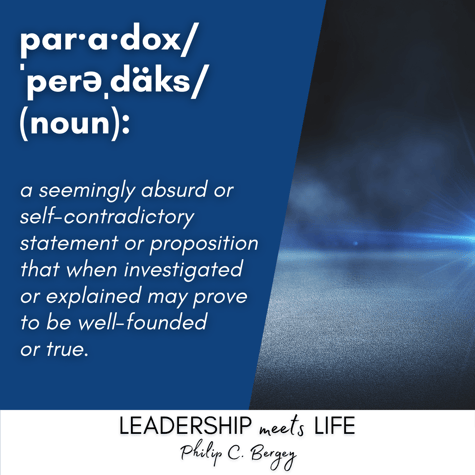
The key here is the word “seemingly.” When investigated further, when I can be open-minded enough to imagine there’s another truth here, I can realize that both are needed to benefit from both parts of the polarity.
As a practical takeaway from this more theoretical yet vital model of navigating polarities, check out the Strategy + Leadership article by Adam Bryant and Kevin Sharer, Can You Master the Inner Game of Leadership?
They make a convincing case for practicing paradox where leadership meets life:
- Be confident and humble
- Be urgent and patient
- Be compassionate and demanding
- Be optimistic and realistic
- Read the weather and set it
- Create freedom and structure
- Be selfless and focus on your well-being

So are polarities opposites or partners? Well, the answer seems to be yes. They can be both. The challenge in leadership and life broadly is first to identify the difference between a problem and a polarity.
Polarities are too quickly viewed as opposites with one pole to be avoided. If it is truly a polarity—in which both poles need to exist for the good of the whole—observe how the two poles function, and then notice your preference or perhaps even whether you are identifying the benefits of one of the poles while comparing those benefits to the overuses of the other pole.
The challenge and opportunity with a true polarity is to determine how to get the benefits of both poles and navigate that dynamic tension over time. In coaching leaders of all types over the past several decades, I’ve noticed that many of the challenges leaders face often include a polarity. And typically the real hurdle is to have a sufficiently open mind to see the benefits of the less-preferred pole and then to make adjustments to integrate the benefits of that less-preferred pole. At first, it may feel like accommodating the enemy, but making room for that Third Way yields long-term benefits. Try it!

- How do you manage your ego, which the trappings of leadership have a way of inflating, so that you don’t become overly confident and start communicating in ways that are off-putting to people?
- How do you handle all of the stresses from the endless demands, the weight of expectations, and the consequences of your decisions?
- How do you remain calm on the outside when you may be in turmoil on the inside?
- Where do you get the stamina to be your very best, in every encounter, through days of back-to-back meetings with different groups, all of which have outsized expectations of you?
- How do you make time for yourself so you can reflect beyond the demands and pressures of today to peer over the horizon?
- How do you nourish yourself in some intellectual or cultural way so that you can feel inspired, to better inspire others?
- How do you find someone who has no other agenda than to help you and can be a trusted sounding board for your ideas and is willing to simply listen to you vent?
- How do you take care of your health?
Excerpt from Can You Master the Inner Game of Leadership? by Adam Bryant and Kevin Sharer.

The next blog post will focus on the difference between types of problems leaders face using a brilliant approach by Ronald Heifetz and his colleagues. We will look at the difference between technical problems that have known solutions compared with adaptive challenges that require learning and discovery before fixes can be applied. We will also look at these different types of problems and challenges alongside today’s focus on polarities.
Don’t miss it! If you haven’t yet signed up for the Leadership Meets Life Blog and Podcast click here for more information and to sign up!
Let me know how you’re connecting with the Leadership Meets Life Blog and Podcast. In what ways does this week’s topic of navigating polarities challenge or inspire you? I’d love to hear from you! You can reach me directly at philb@designgroupintl.com or by visiting my website.

Listen to the recent podcast that digs into this topic more:
Access more resources for your leadership journey:
 |
 |
 |
Tags:
organizational decision making, polarity management, leadership, relationships, navigating paradox, polarities, suffering paradox, Leadership Meets Life Blog/Philip%20C.%20Bergey%20Headshot%20(300x300).png)
May 25, 2021
.png?width=100&name=Phil%20Bergey%20Headshot%20(1).png)

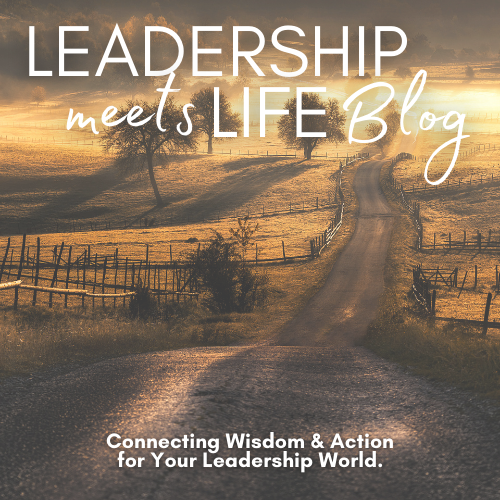
Comments